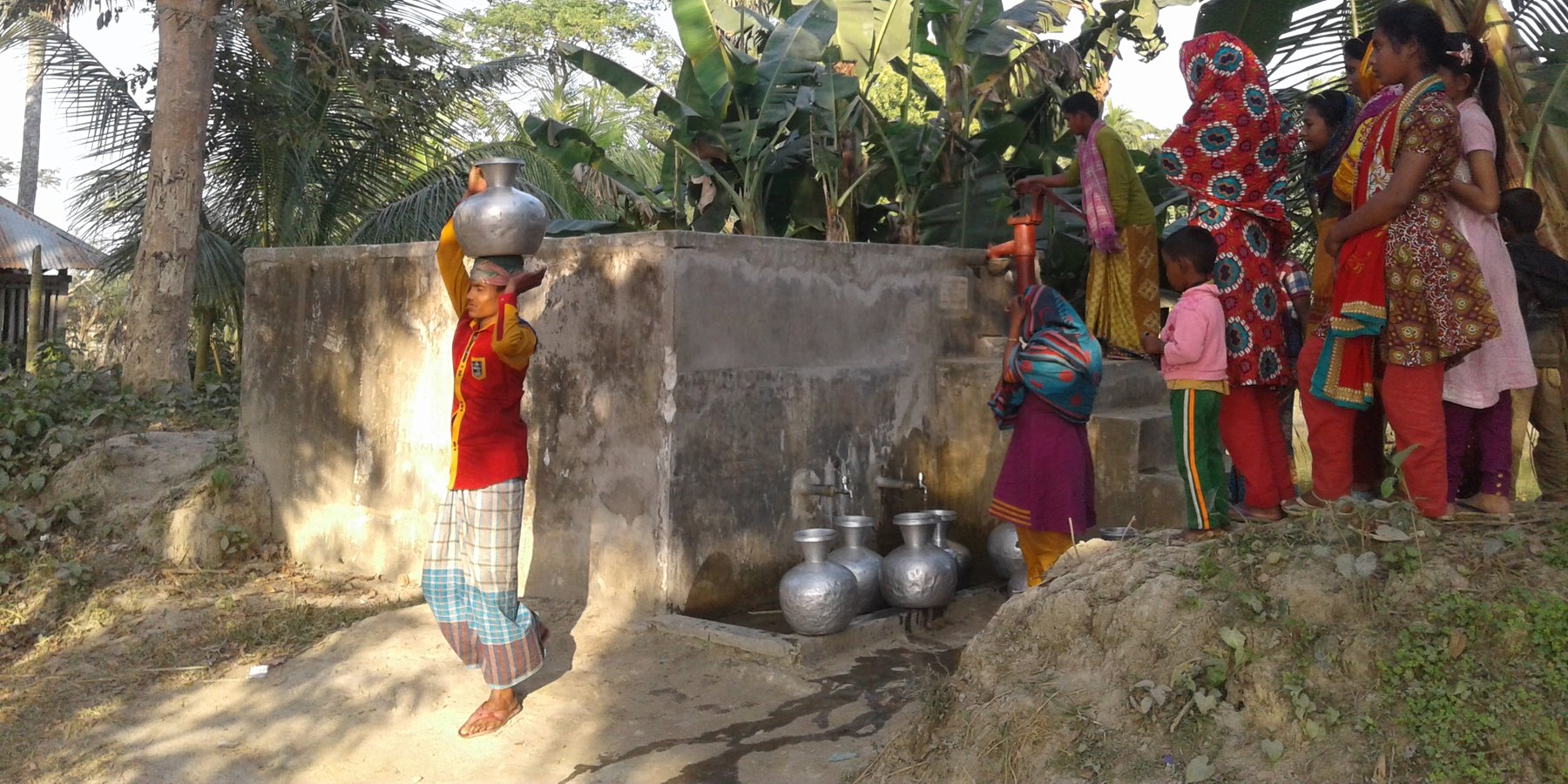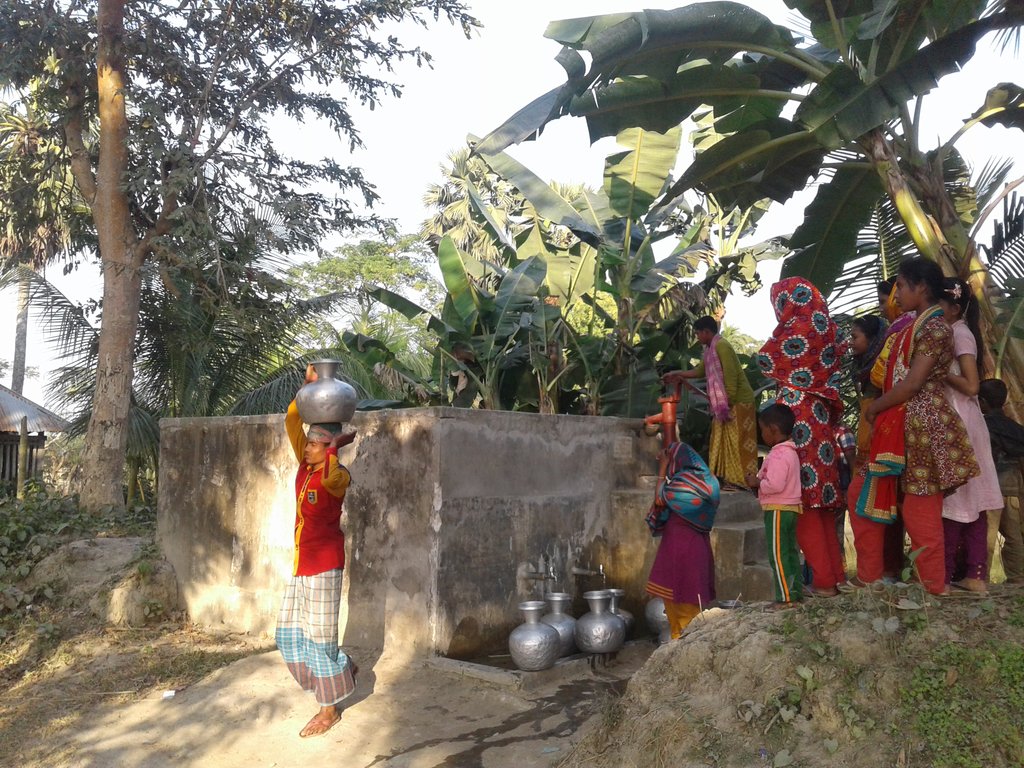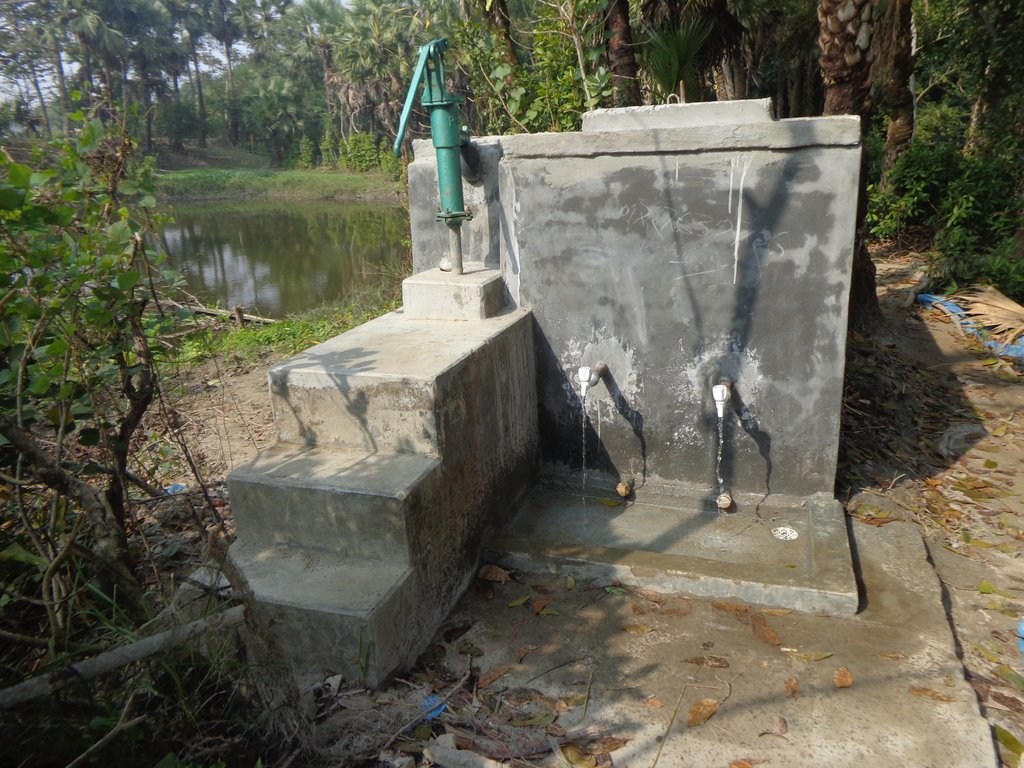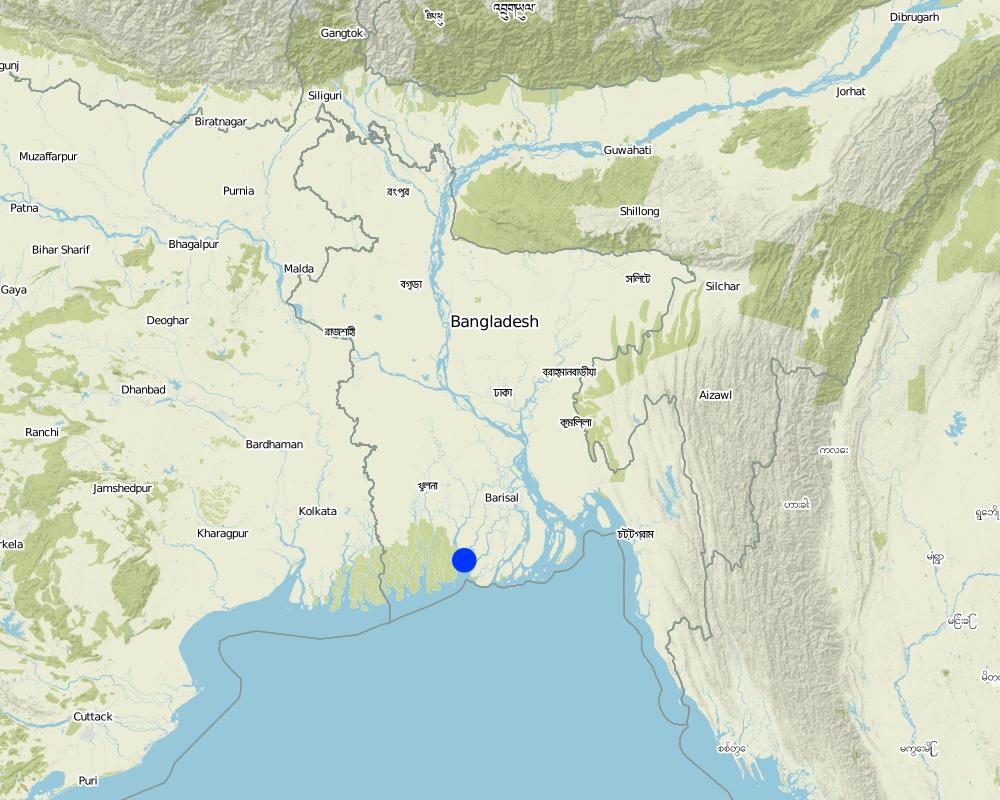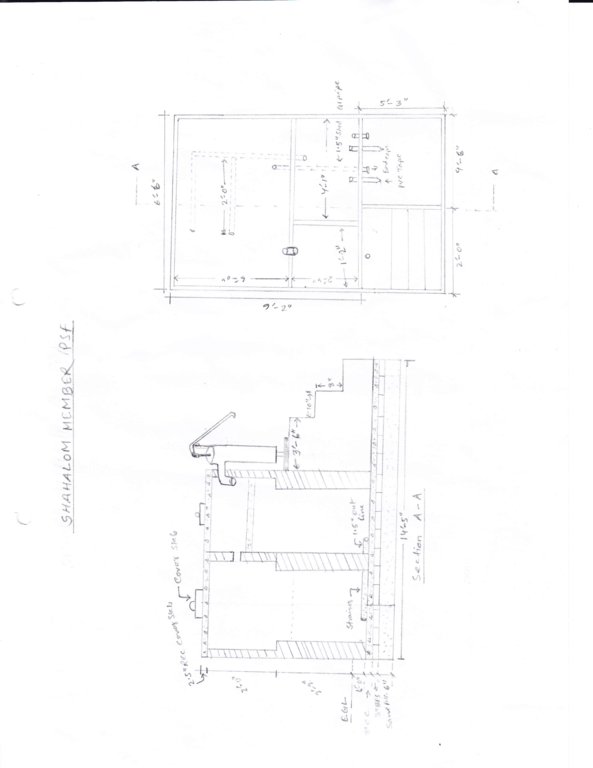Pond Sand Filter (PSF) [Bangladesh]
- Creation:
- Update:
- Compiler: John Brogan
- Editors: Shahid Kamal, Md. Rahmatullah Faruque
- Reviewers: Alexandra Gavilano, Hanspeter Liniger, Nicole Harari
FILTER
technologies_550 - Bangladesh
View sections
Expand all Collapse all1. General information
1.2 Contact details of resource persons and institutions involved in the assessment and documentation of the Technology
Name of project which facilitated the documentation/ evaluation of the Technology (if relevant)
Book project: where people and their land are safer - A Compendium of Good Practices in Disaster Risk Reduction (DRR) (where people and their land are safer)Name of the institution(s) which facilitated the documentation/ evaluation of the Technology (if relevant)
Terre des Hommes (Terre des Hommes) - Switzerland1.3 Conditions regarding the use of data documented through WOCAT
When were the data compiled (in the field)?
22/08/2016
The compiler and key resource person(s) accept the conditions regarding the use of data documented through WOCAT:
Yes
1.4 Declaration on sustainability of the described Technology
Is the Technology described here problematic with regard to land degradation, so that it cannot be declared a sustainable land management technology?
No
Comments:
There is no land degradation as the PSF pond embankment is surrounded with vegetable products and serves as a source of water. This technology reduces water shortage during disasters like drought or coastal flood.
2. Description of the SLM Technology
2.1 Short description of the Technology
Definition of the Technology:
Pond Sand Filter (PSF) increases flood resilience, providing an alternative source of drinking water during disaster events
2.2 Detailed description of the Technology
Description:
The technology is embedded in a natural environment. Necessary materials include cement, sand, brick, rods, pipes, etc. There are multiple purposes of the technology which filters pond water and supplies drinking water for consummation and cooking. To establish/maintain this technology, we need to form and build capacities of PSF committees, which operate and maintain the PSF, excavate the pond and raise the pond embankment, fence the PSF for protection, open a bank account for smooth operations and establish links with research-based organizations and local government authorities working on improved water management technology. The principal benefit of the technology is that households have access to drinking water close to their home. In addition, it enables cultivating vegetables on the embankment of PSF which can support a balanced nutrition and can generate additional income. There is no noticeable disagreement at community level about the technology because it provides a reliable and alternative source of drinking water especially during disaster event.
2.3 Photos of the Technology
2.5 Country/ region/ locations where the Technology has been applied and which are covered by this assessment
Country:
Bangladesh
Region/ State/ Province:
Patharghata, Barguna district in coastal region
Further specification of location:
Vill: Baratangra, Ward:4, Union: Patharghata Union Parishad
Map
×2.6 Date of implementation
Indicate year of implementation:
2016
2.7 Introduction of the Technology
Specify how the Technology was introduced:
- through projects/ external interventions
3. Classification of the SLM Technology
3.1 Main purpose(s) of the Technology
- reduce, prevent, restore land degradation
- preserve/ improve biodiversity
- adapt to climate change/ extremes and its impacts
3.2 Current land use type(s) where the Technology is applied

Unproductive land
3.3 Further information about land use
Water supply for the land on which the Technology is applied:
- rainfed
Number of growing seasons per year:
- 2
3.4 SLM group to which the Technology belongs
- surface water management (spring, river, lakes, sea)
3.5 Spread of the Technology
Specify the spread of the Technology:
- applied at specific points/ concentrated on a small area
3.6 SLM measures comprising the Technology

structural measures
- S5: Dams, pans, ponds
- S7: Water harvesting/ supply/ irrigation equipment
3.7 Main types of land degradation addressed by the Technology

water degradation
- Hs: change in quantity of surface water
3.8 Prevention, reduction, or restoration of land degradation
Specify the goal of the Technology with regard to land degradation:
- not applicable
4. Technical specifications, implementation activities, inputs, and costs
4.1 Technical drawing of the Technology
4.2 Technical specifications/ explanations of technical drawing
Height-4 feet 2 inch, Length-14 feet 5 inch, Width-7 feet with 1.5 km vertical interval structure having 0.4 decimal catchment area. The capacity of PSF is 2500 liter water. The construction materials used in rebuilding PSF include brick, sand, brick chips, cement, GI Pipe, water tap and MS Rod.
4.3 General information regarding the calculation of inputs and costs
Specify how costs and inputs were calculated:
- per Technology unit
Specify unit:
Pond Sand Filter
Specify volume, length, etc. (if relevant):
average 36.45 meter
Specify currency used for cost calculations:
- US Dollars
Indicate average wage cost of hired labour per day:
5 $ per day for each labor
4.4 Establishment activities
| Activity | Type of measure | Timing | |
|---|---|---|---|
| 1. | Community consultation for Committee Formation | Management | Before onset of rain |
| 2. | Fund raising initiative | Management | Before onset of rain |
| 3. | Approval from by Union Parishad | Management | Before onset of rain |
| 4. | Needs assessement | Management | Before onset of rain |
| 5. | Technician selection for reconstruction | Structural | Before onset of rain |
| 6. | Contribution from PSF committee | Management | Before onset of rain |
| 7. | Contribution from Tdh | Management | Before onset of rain |
| 8. | Commencement of PSF reconstruction | Structural | Before onset of rain |
| 9. | Excavating | Structural | Before onset of rain |
| 10. | Pond fencing | Structural | Before onset of rain |
| 11. | Pond embankment | Structural | Before onset of rain |
4.5 Costs and inputs needed for establishment
| Specify input | Unit | Quantity | Costs per Unit | Total costs per input | % of costs borne by land users | |
|---|---|---|---|---|---|---|
| Labour | Excavation work | days | 30.0 | 5.0 | 150.0 | 10.0 |
| Equipment | Repairing tools | 1 | 4.0 | 15.0 | 60.0 | |
| Equipment | Tubewell | 1 | 1.0 | 29.0 | 29.0 | 10.0 |
| Fertilizers and biocides | bleeching | 1 | 0.5 | 3.0 | 1.5 | 10.0 |
| Construction material | ||||||
| Construction material | ||||||
| Construction material | bricks | pieces | 15.0 | 1.5 | 22.5 | 10.0 |
| Construction material | sand | pieces/bags | 80.0 | 0.5 | 40.0 | 10.0 |
| Other | brickchips | pieces | 10.0 | 1.0 | 10.0 | 10.0 |
| Other | MS rod | pieces | 30.0 | 1.0 | 30.0 | |
| Other | Cement | bag | 12.0 | 6.0 | 72.0 | |
| Total costs for establishment of the Technology | 415.0 | |||||
If land user bore less than 100% of costs, indicate who covered the remaining costs:
The remaining costs bore by the project contribution. It's a mode of cost sharing and developing a culture of belongingness and sustainability.
4.6 Maintenance/ recurrent activities
| Activity | Type of measure | Timing/ frequency | |
|---|---|---|---|
| 1. | Repairing | Other measures | Before onset of rains |
| 2. | Cleaning | Management | Before onset of rains |
4.7 Costs and inputs needed for maintenance/ recurrent activities (per year)
| Specify input | Unit | Quantity | Costs per Unit | Total costs per input | % of costs borne by land users | |
|---|---|---|---|---|---|---|
| Labour | For cleaning | days | 4.0 | 14.0 | 56.0 | 100.0 |
| Fertilizers and biocides | bleeching powder | bag | 5.0 | 2.0 | 10.0 | |
| Construction material | sand | pieces/bags | 80.0 | 1.0 | 80.0 | 100.0 |
| Construction material | Brick chips | pieces | 10.0 | 5.0 | 50.0 | |
| Other | Cement | bag | 6.0 | 12.0 | 72.0 | |
| Total costs for maintenance of the Technology | 268.0 | |||||
4.8 Most important factors affecting the costs
Describe the most determinate factors affecting the costs:
Comparatively, construction materials costs was reflected as expensive cost.
5. Natural and human environment
5.1 Climate
Annual rainfall
- < 250 mm
- 251-500 mm
- 501-750 mm
- 751-1,000 mm
- 1,001-1,500 mm
- 1,501-2,000 mm
- 2,001-3,000 mm
- 3,001-4,000 mm
- > 4,000 mm
Indicate the name of the reference meteorological station considered:
www.discoverybangladesh.com
Agro-climatic zone
- semi-arid
5.2 Topography
Slopes on average:
- flat (0-2%)
- gentle (3-5%)
- moderate (6-10%)
- rolling (11-15%)
- hilly (16-30%)
- steep (31-60%)
- very steep (>60%)
Landforms:
- plateau/plains
- ridges
- mountain slopes
- hill slopes
- footslopes
- valley floors
Altitudinal zone:
- 0-100 m a.s.l.
- 101-500 m a.s.l.
- 501-1,000 m a.s.l.
- 1,001-1,500 m a.s.l.
- 1,501-2,000 m a.s.l.
- 2,001-2,500 m a.s.l.
- 2,501-3,000 m a.s.l.
- 3,001-4,000 m a.s.l.
- > 4,000 m a.s.l.
Indicate if the Technology is specifically applied in:
- not relevant
5.3 Soils
Soil depth on average:
- very shallow (0-20 cm)
- shallow (21-50 cm)
- moderately deep (51-80 cm)
- deep (81-120 cm)
- very deep (> 120 cm)
Soil texture (topsoil):
- medium (loamy, silty)
Soil texture (> 20 cm below surface):
- medium (loamy, silty)
Topsoil organic matter:
- medium (1-3%)
5.4 Water availability and quality
Ground water table:
5-50 m
Availability of surface water:
poor/ none
Water quality (untreated):
poor drinking water (treatment required)
Is water salinity a problem?
No
Is flooding of the area occurring?
Yes
5.5 Biodiversity
Species diversity:
- medium
Habitat diversity:
- medium
5.6 Characteristics of land users applying the Technology
Sedentary or nomadic:
- Sedentary
Market orientation of production system:
- subsistence (self-supply)
Off-farm income:
- 10-50% of all income
Relative level of wealth:
- poor
Individuals or groups:
- groups/ community
Level of mechanization:
- animal traction
- mechanized/ motorized
Gender:
- women
- men
Age of land users:
- middle-aged
- elderly
5.7 Average area of land owned or leased by land users applying the Technology
- < 0.5 ha
- 0.5-1 ha
- 1-2 ha
- 2-5 ha
- 5-15 ha
- 15-50 ha
- 50-100 ha
- 100-500 ha
- 500-1,000 ha
- 1,000-10,000 ha
- > 10,000 ha
Is this considered small-, medium- or large-scale (referring to local context)?
- small-scale
5.8 Land ownership, land use rights, and water use rights
Land ownership:
- individual, not titled
Land use rights:
- individual
Water use rights:
- open access (unorganized)
5.9 Access to services and infrastructure
health:
- poor
- moderate
- good
education:
- poor
- moderate
- good
technical assistance:
- poor
- moderate
- good
employment (e.g. off-farm):
- poor
- moderate
- good
markets:
- poor
- moderate
- good
energy:
- poor
- moderate
- good
roads and transport:
- poor
- moderate
- good
drinking water and sanitation:
- poor
- moderate
- good
financial services:
- poor
- moderate
- good
6. Impacts and concluding statements
6.1 On-site impacts the Technology has shown
Socio-economic impacts
Water availability and quality
drinking water availability
Quantity before SLM:
1
Quantity after SLM:
3
Comments/ specify:
The availability of water was very little before setting up such technology
Income and costs
economic disparities
Quantity before SLM:
1
Quantity after SLM:
3
Socio-cultural impacts
health situation
Quantity before SLM:
1
Quantity after SLM:
3
Comments/ specify:
Water borne diseases was in epidemic form before setting up PSF technology which was getting gradually decreased.
6.2 Off-site impacts the Technology has shown
water availability
Quantity before SLM:
1
Quantity after SLM:
3
Comments/ specify:
The usage of surface water has been promoted significantly as it contains acceptable level of iron
6.3 Exposure and sensitivity of the Technology to gradual climate change and climate-related extremes/ disasters (as perceived by land users)
Climate-related extremes (disasters)
Climatological disasters
| How does the Technology cope with it? | |
|---|---|
| drought | well |
Hydrological disasters
| How does the Technology cope with it? | |
|---|---|
| flash flood | well |
Biological disasters
| How does the Technology cope with it? | |
|---|---|
| insect/ worm infestation | moderately |
Comments:
PSF serves as disaster resilient Technology that can well cope with the effects of climate change.
6.4 Cost-benefit analysis
How do the benefits compare with the establishment costs (from land users’ perspective)?
Short-term returns:
slightly positive
Long-term returns:
positive
How do the benefits compare with the maintenance/ recurrent costs (from land users' perspective)?
Short-term returns:
neutral/ balanced
Long-term returns:
positive
6.5 Adoption of the Technology
- more than 50%
Of all those who have adopted the Technology, how many have did so spontaneously, i.e. without receiving any material incentives/ payments?
- 0-10%
6.6 Adaptation
Has the Technology been modified recently to adapt to changing conditions?
No
6.7 Strengths/ advantages/ opportunities of the Technology
| Strengths/ advantages/ opportunities in the land user’s view |
|---|
| The Technology is useful for supplying drinking water at household level and can meet the nutritional needs through cultivating medicinal plants and vegetables at the pond embankment |
| Strengths/ advantages/ opportunities in the compiler’s or other key resource person’s view |
|---|
| The Technology is conducive for ensuring supply of water for drinking, cooking and irrigation purposes if the community is motivated and understand the impact of PSF when faced with water shortage during dry season and other disaster events. |
6.8 Weaknesses/ disadvantages/ risks of the Technology and ways of overcoming them
| Weaknesses/ disadvantages/ risks in the compiler’s or other key resource person’s view | How can they be overcome? |
|---|---|
| Every six months, the PSF needs to be taken care of. This requires some maintenance costs that must be deposited every month for smooth operations. PSF DRR fencing is also necessary to protect PSF against animals. | Deposit monthly saving to incur the six monthly maintenance costs as well as create relationship with local research organization to improve the cost-effectiveness of the technology |
7. References and links
7.1 Methods/ sources of information
- field visits, field surveys
Six to seven
- compilation from reports and other existing documentation
five
Links and modules
Expand all Collapse allLinks
No links
Modules
No modules


